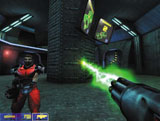 The
original Unreal was about one thing: graphics. Ostensibly a first person shooter, its
single player game was outright boring, possessing neither the personality of a Duke Nukem
nor the plot of a Half-Life. This same thing could be said, of course, about Quake
II’s single player game, but Quake II at least had a king-hell multiplayer game. And
Unreal did not. In fact, Unreal’s
multiplayer code was a mess; you could just forget about internet games, and even LAN
games were often mired in chop. Mix some in
some uninspired maps, and Unreal stands out as one of the great multiplayer gaming
fiascoes. Even the late unlamented add-on pack, Return to Na Pali--which allowed you to
escape from the same place you escaped from in the original—was uninspired and did
little to redeem its original’s shortcomings. But man, did they look pretty. Unreal
is still unsurpassed graphically, and anyone who played it will never forget the first
time they stepped out of the prison ship and into the incredibly rendered world of Na
Pali. The waterfall itself was worth the price of admission. Unfortunately, even the
game’s beauty was marred by the fact that you could only see it if you were running a
3dfx card. Since it shipped with no support for Open GL or Direct 3D, the game never made
it onto a lot of gamers’ hard drives. The
original Unreal was about one thing: graphics. Ostensibly a first person shooter, its
single player game was outright boring, possessing neither the personality of a Duke Nukem
nor the plot of a Half-Life. This same thing could be said, of course, about Quake
II’s single player game, but Quake II at least had a king-hell multiplayer game. And
Unreal did not. In fact, Unreal’s
multiplayer code was a mess; you could just forget about internet games, and even LAN
games were often mired in chop. Mix some in
some uninspired maps, and Unreal stands out as one of the great multiplayer gaming
fiascoes. Even the late unlamented add-on pack, Return to Na Pali--which allowed you to
escape from the same place you escaped from in the original—was uninspired and did
little to redeem its original’s shortcomings. But man, did they look pretty. Unreal
is still unsurpassed graphically, and anyone who played it will never forget the first
time they stepped out of the prison ship and into the incredibly rendered world of Na
Pali. The waterfall itself was worth the price of admission. Unfortunately, even the
game’s beauty was marred by the fact that you could only see it if you were running a
3dfx card. Since it shipped with no support for Open GL or Direct 3D, the game never made
it onto a lot of gamers’ hard drives.
So we were skeptical about Unreal
Tournament. Epic didn’t seem to have much talent for constructing single-player
storylines, so we weren’t heartbroken to see them dump that. But given Unreal’s
awful multiplayer, we weren’t expecting anything to challenge Quake III’s
gameplay. We were just expecting something real pretty.
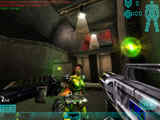 And Unreal Tournament is
real pretty. But here’s the kicker: it also has great single-player and multiplayer
games, tight and fast multiplayer code, an elegant interface, support for Open GL and
Direct 3D, generally excellent maps, and enough variety and game modes to keep even the
most demanding fragmeister busy for a long, long, time. Unreal Tournament ups the FPS
multiplayer ante to backroom Vegas levels; Quake III had better be real, real, good if it
wants to sit at the same table. And Unreal Tournament is
real pretty. But here’s the kicker: it also has great single-player and multiplayer
games, tight and fast multiplayer code, an elegant interface, support for Open GL and
Direct 3D, generally excellent maps, and enough variety and game modes to keep even the
most demanding fragmeister busy for a long, long, time. Unreal Tournament ups the FPS
multiplayer ante to backroom Vegas levels; Quake III had better be real, real, good if it
wants to sit at the same table.
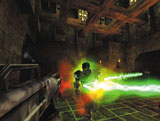 Unreal Tournament has five
different gameplay modes. Of course the old standards are here, and in UT you’ll find
both FPS meat-and-potatoes modes: deathmatch (and team deathmatch) as well as capture the
flag. But UT has also thrown in some interesting new modes. In Domination, you have to
seize and hold specific points on the map; it’s a lot like the take and hold missions
in Tribes, and makes for an absolutely murderous game as you and your teammates take and
retake the contested areas. Even better is the new Assault mode. These games are timed and
mission-oriented, and in them you’ll be tasked with either attacking an enemy base
and accomplishing a number of objectives (for instance, blowing up an enemy tank
prototype) or with preventing those objectives from being accomplished. Epic has put a lot
of thought into the Assault games, and they’re uniformly stunning, combining
interesting and gorgeous maps with challenging tactical situations. In one, you’ll
have to board an enemy frigate, in another, you’ll jump from a helicopter onto a
moving train and work your way from car to car as you approach an enemy command center. In
my favorite, which is right out of Saving Private Ryan (and appropriately named Operation
Overlord), you disembark from a landing craft right onto a beach strewn with barbed wire
and covered by heavy weapons fire from bunkers. It’s a brilliant gaming moment. The
final mode is Last Man Standing. You’ll start the game loaded up with all weapons and
a limited number of lives, and the game continues until there’s but one lad left
alive. It’s hardcore stuff. Unreal Tournament has five
different gameplay modes. Of course the old standards are here, and in UT you’ll find
both FPS meat-and-potatoes modes: deathmatch (and team deathmatch) as well as capture the
flag. But UT has also thrown in some interesting new modes. In Domination, you have to
seize and hold specific points on the map; it’s a lot like the take and hold missions
in Tribes, and makes for an absolutely murderous game as you and your teammates take and
retake the contested areas. Even better is the new Assault mode. These games are timed and
mission-oriented, and in them you’ll be tasked with either attacking an enemy base
and accomplishing a number of objectives (for instance, blowing up an enemy tank
prototype) or with preventing those objectives from being accomplished. Epic has put a lot
of thought into the Assault games, and they’re uniformly stunning, combining
interesting and gorgeous maps with challenging tactical situations. In one, you’ll
have to board an enemy frigate, in another, you’ll jump from a helicopter onto a
moving train and work your way from car to car as you approach an enemy command center. In
my favorite, which is right out of Saving Private Ryan (and appropriately named Operation
Overlord), you disembark from a landing craft right onto a beach strewn with barbed wire
and covered by heavy weapons fire from bunkers. It’s a brilliant gaming moment. The
final mode is Last Man Standing. You’ll start the game loaded up with all weapons and
a limited number of lives, and the game continues until there’s but one lad left
alive. It’s hardcore stuff.
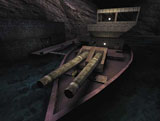 You can play any of these modes in
either single-player or multiplayer, and the most surprising thing about UT is just how
good the single-player game is. In single player tournament, you’ll start off playing
deathmatch against a single bot; as you progress up the ladder, you’ll deathmatch
against more and tougher bots on more complex maps, and other game modes will begin to
open as well. This is a great learning tool for those new to FPS multiplayer games, and
Epic also includes a short but instructive tutorial that explains each mode for newbies.
But the thing that really makes the single player game stand out is the bots. In a word,
they’re smart. Real smart. The bots in the single-player game will give you a run for
your money, especially on the higher difficulty levels. They’ll take cover, attempt
to gather the most powerful weapons, seek out health when injured, and run from a
mismatch. You can also command bots on your team through a very simple and efficient
interface, and they do a surprisingly good job of following orders. They’ll even
message you from time to time when they take position or spot an enemy. Of course,
sometimes the bot AI falters; for instance, while defending in the Operation Overlord
scenario I sat in a tower with a sniper rifle and picked off every bot as they crossed the
beach; they never caught on. But overall, this is the best bot AI we’ve ever
witnessed. You can play any of these modes in
either single-player or multiplayer, and the most surprising thing about UT is just how
good the single-player game is. In single player tournament, you’ll start off playing
deathmatch against a single bot; as you progress up the ladder, you’ll deathmatch
against more and tougher bots on more complex maps, and other game modes will begin to
open as well. This is a great learning tool for those new to FPS multiplayer games, and
Epic also includes a short but instructive tutorial that explains each mode for newbies.
But the thing that really makes the single player game stand out is the bots. In a word,
they’re smart. Real smart. The bots in the single-player game will give you a run for
your money, especially on the higher difficulty levels. They’ll take cover, attempt
to gather the most powerful weapons, seek out health when injured, and run from a
mismatch. You can also command bots on your team through a very simple and efficient
interface, and they do a surprisingly good job of following orders. They’ll even
message you from time to time when they take position or spot an enemy. Of course,
sometimes the bot AI falters; for instance, while defending in the Operation Overlord
scenario I sat in a tower with a sniper rifle and picked off every bot as they crossed the
beach; they never caught on. But overall, this is the best bot AI we’ve ever
witnessed.
The bots also play a big role in
Unreal’s extraordinary multiplayer game; if you want to play Assault with four on a
side but can only scare up five human players, no problem; just add three bots to the mix.
Believe me, they’re as good as most random human players, and you’ll rarely feel
them to be a handicap. And for a game this beautiful, it plays very smoothly in
multiplayer. Over our LAN network, we experienced virtually no lag. With a 56.6 modem, we still managed to find plenty
of games running with pings around 250; while you’ll be at a bit of a disadvantage in
these games vs. DSL players, they’re still very playable. And UT makes it easy to
find games. If you’ve got an Internet connection, all you’ve got to do is click
on the “Find Internet Game” menu, and you’ll quickly be given a listing of
servers in order of ping time. This is the
best out-of-the-box multiplayer support since Tribes, and here UT gets big points. Its
ease of installation and use, coupled with its tutorials, will allow many newbies to find
their way online. Where we can frag them with
ease. Thank you, thank you, thank you.
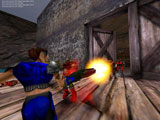 UT includes 12 weapons, from your
basic pistol to an upgraded razor jack to the Redeemer, which launches a mini-nuke missile
and will kill you a lot until you get the hang of guiding it. While none of the weapons
are inspired in the Half-Life-alien-weapon sort of way, they are all nicely balanced and
include secondary fire modes for variety. My
favorite’s the Flak Cannon, which is sort of like a shotgun (which is, by the way,
not included) that shoots rounds of molten shrapnel in primary fire mode. Not much of a weapon at range, but it will flat
put someone on their ass from up-close-and-personal distance. But all’s not lost if
you do need to reach out and touch someone--the Flak Cannon’s secondary fire mode
will lob shrapnel grenades a goodly distance. You’ll quickly learn when to use
weapons to their best advantage, and you’ll also learn that some maps favor certain
weapons over others. UT includes 12 weapons, from your
basic pistol to an upgraded razor jack to the Redeemer, which launches a mini-nuke missile
and will kill you a lot until you get the hang of guiding it. While none of the weapons
are inspired in the Half-Life-alien-weapon sort of way, they are all nicely balanced and
include secondary fire modes for variety. My
favorite’s the Flak Cannon, which is sort of like a shotgun (which is, by the way,
not included) that shoots rounds of molten shrapnel in primary fire mode. Not much of a weapon at range, but it will flat
put someone on their ass from up-close-and-personal distance. But all’s not lost if
you do need to reach out and touch someone--the Flak Cannon’s secondary fire mode
will lob shrapnel grenades a goodly distance. You’ll quickly learn when to use
weapons to their best advantage, and you’ll also learn that some maps favor certain
weapons over others.
Speaking of maps, most of those
included in UT are first-rate. From a wooden
galleon to a spaceship traveling at hyperspace speed, UT’s maps are both challenging
and graphically stunning. With about 60 of them included in the game, you won’t get
bored anytime soon. And by the time you do, plenty of
players will have used the included editor to post new mods.
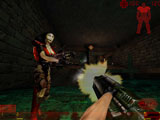 Of course, we’ve saved the
best for last. Unreal Tournament's graphics are just stunning, without a doubt the
prettiest game we’ve ever played. It takes a bit of a horse of a machine to squeeze
out everything the engine’s got to offer, but our PIII 450’s with 128 megs of
RAM and Viper 770 cards ran very smoothly at high res and 32-bit color. And by the way,
the first run of UT comes with a little sheet warning Direct 3D users that the game might
have trouble detecting their cards. Since we run TNT 2s, we were pretty upset about this,
but it’s no big deal; just change your settings from software rendering, and all is
gravy. Of course, we’ve saved the
best for last. Unreal Tournament's graphics are just stunning, without a doubt the
prettiest game we’ve ever played. It takes a bit of a horse of a machine to squeeze
out everything the engine’s got to offer, but our PIII 450’s with 128 megs of
RAM and Viper 770 cards ran very smoothly at high res and 32-bit color. And by the way,
the first run of UT comes with a little sheet warning Direct 3D users that the game might
have trouble detecting their cards. Since we run TNT 2s, we were pretty upset about this,
but it’s no big deal; just change your settings from software rendering, and all is
gravy.
But that’s the only thing we
were upset about during our hours of pretty much nonstop gameplay; Unreal Tournament is a
great game, and as remarkable a turnaround from the original’s abysmal multiplayer as
the ’99 Rams are from the ’98 version. If you’re at all a fan of
multiplayer games or first person shooters, buy this game.
--Rick Fehrenbacher |
